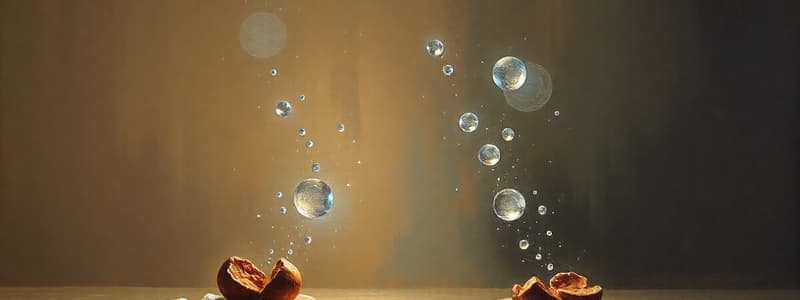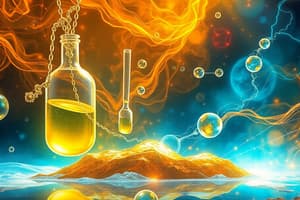Podcast
Questions and Answers
What is the primary characteristic of a system at chemical equilibrium?
What is the primary characteristic of a system at chemical equilibrium?
- The concentrations of reactants are significantly higher than products.
- The system consists only of products; no reactants are present.
- The rates of the forward and reverse reactions are equal. (correct)
- All reaction ceases as reactants are completely converted to products.
What distinguishes chemical equilibrium from physical equilibrium?
What distinguishes chemical equilibrium from physical equilibrium?
- Physical equilibrium involves changes in temperature, whereas chemical equilibrium does not.
- Chemical equilibrium occurs only in closed systems, unlike physical equilibrium.
- Chemical equilibrium involves different substances as reactants and products, while physical equilibrium involves different phases of the same substance. (correct)
- Physical equilibrium is achieved instantaneously, while chemical equilibrium takes time.
Consider a reversible reaction in a closed system. What initial action will start the reverse reaction?
Consider a reversible reaction in a closed system. What initial action will start the reverse reaction?
- Addition of more reactants to the system.
- Removal of some of the reactants.
- Lowering the temperature of the system.
- Formation of some product molecules. (correct)
If the equilibrium constant (K) for a reaction is much smaller than 1, what does this indicate about the equilibrium?
If the equilibrium constant (K) for a reaction is much smaller than 1, what does this indicate about the equilibrium?
In the equilibrium reaction between $N_2O_4(g)
ightleftharpoons 2NO_2(g)$, what would be observed if the reaction starts with pure $N_2O_4$?
In the equilibrium reaction between $N_2O_4(g) ightleftharpoons 2NO_2(g)$, what would be observed if the reaction starts with pure $N_2O_4$?
Consider the reversible reaction $A + B
ightleftharpoons C + D$. At equilibrium, how are the rates of formation of C and A related?
Consider the reversible reaction $A + B ightleftharpoons C + D$. At equilibrium, how are the rates of formation of C and A related?
For the reaction $N_2O_4(g)
ightleftharpoons 2NO_2(g)$, what does the ratio $[NO_2]^2/[N_2O_4]$ represent at equilibrium?
For the reaction $N_2O_4(g) ightleftharpoons 2NO_2(g)$, what does the ratio $[NO_2]^2/[N_2O_4]$ represent at equilibrium?
In a system at equilibrium, if more reactant is added, what immediate effect will this have on the forward and reverse reaction rates?
In a system at equilibrium, if more reactant is added, what immediate effect will this have on the forward and reverse reaction rates?
Why is chemical equilibrium described as a 'dynamic process'?
Why is chemical equilibrium described as a 'dynamic process'?
For the reaction $2A(g)
ightleftharpoons B(g)$, the equilibrium constant K is given by:
For the reaction $2A(g) ightleftharpoons B(g)$, the equilibrium constant K is given by:
Which of the following is an example of physical equilibrium?
Which of the following is an example of physical equilibrium?
How can an equilibrium state be achieved for the reaction $N_2O_4(g)
ightleftharpoons 2NO_2(g)$?
How can an equilibrium state be achieved for the reaction $N_2O_4(g) ightleftharpoons 2NO_2(g)$?
If a reaction has an equilibrium constant K = 1, what does this indicate about the concentrations of reactants and products at equilibrium?
If a reaction has an equilibrium constant K = 1, what does this indicate about the concentrations of reactants and products at equilibrium?
For the equilibrium $H_2O(l)
ightleftharpoons H_2O(g)$ in a closed container, what is the relationship between the number of water molecules leaving and returning to the liquid phase at equilibrium?
For the equilibrium $H_2O(l) ightleftharpoons H_2O(g)$ in a closed container, what is the relationship between the number of water molecules leaving and returning to the liquid phase at equilibrium?
What is the correct expression for the equilibrium constant $K$ for the following reaction: $aA + bB
ightleftharpoons cC + dD$?
What is the correct expression for the equilibrium constant $K$ for the following reaction: $aA + bB ightleftharpoons cC + dD$?
Consider the following reaction at equilibrium: $2SO_2(g) + O_2(g)
ightleftharpoons 2SO_3(g)$. If the concentration of $SO_2$ is increased, what will happen to the concentration of $O_2$ at the new equilibrium?
Consider the following reaction at equilibrium: $2SO_2(g) + O_2(g) ightleftharpoons 2SO_3(g)$. If the concentration of $SO_2$ is increased, what will happen to the concentration of $O_2$ at the new equilibrium?
Which statement is correct regarding the rate of forward and reverse reactions at equilibrium?
Which statement is correct regarding the rate of forward and reverse reactions at equilibrium?
What happens to the color intensity of $NO_2$ in a flask when $N_2O_4$ dissociates until equilibrium is reached?
What happens to the color intensity of $NO_2$ in a flask when $N_2O_4$ dissociates until equilibrium is reached?
What quantity remains nearly constant at equilibrium, regardless of initial concentrations, for the reaction $N_2O_4(g)
ightleftharpoons 2NO_2(g)$?
What quantity remains nearly constant at equilibrium, regardless of initial concentrations, for the reaction $N_2O_4(g) ightleftharpoons 2NO_2(g)$?
What is true regarding the rates of forward and reverse reactions when a system reaches chemical equilibrium?
What is true regarding the rates of forward and reverse reactions when a system reaches chemical equilibrium?
Flashcards
Chemical Equilibrium
Chemical Equilibrium
State where forward and reverse reaction rates are equal, and reactant/product concentrations remain constant.
Physical Equilibrium
Physical Equilibrium
Equilibrium between phases of the same substance, involving physical changes.
Equilibrium Constant (K)
Equilibrium Constant (K)
A quotient obtained by multiplying equilibrium concentrations of products (raised to stoichiometric coefficients) divided by reactants.
K >> 1
K >> 1
Signup and view all the flashcards
K << 1
K << 1
Signup and view all the flashcards
Study Notes
- Most chemical reactions are reversible, proceeding in both forward and reverse directions.
- Initially, a reversible reaction favors product formation, but the reverse process begins as product molecules form, recreating reactant molecules.
- Chemical equilibrium occurs when the rates of forward and reverse reactions equalize, leading to constant concentrations of reactants and products.
- Chemical equilibrium is a dynamic process.
- Chemical equilibrium involves different substances as reactants and products.
Physical Equilibrium
- Physical equilibrium involves equilibrium between two phases of the same substance, involving physical processes.
- Vaporization of water in a closed container exemplifies physical equilibrium, where the rate of H2O molecules leaving and returning to the liquid phase are equal.
- Physical equilibrium studies yield information like equilibrium vapor pressure.
Chemical Equilibrium Example
- Chemists are particularly interested in chemical equilibrium processes, such as the reversible reaction involving nitrogen dioxide (NO2) and dinitrogen tetroxide (N2O4).
- N2O4 is a colorless gas, whereas NO2 has a dark-brown color.
- Injecting N2O4 into an evacuated flask leads to the formation of NO2 molecules, indicated by a brown color, until equilibrium is reached and the color becomes constant.
- Equilibrium can also be achieved by starting with pure NO2, where the color fades as NO2 molecules combine to form N2O4.
- Starting with a mixture of NO2 and N2O4 and monitoring the system until the color stops changing will also create an equilibrium state.
Equilibrium Constant
- Equilibrium concentrations of NO2 and N2O4 vary depending on starting concentrations.
- The ratio [NO2]^2/[N2O4] at equilibrium gives a nearly constant value that averages 4.63 x 10^-3.
- The equilibrium constant is defined by a quotient, with the numerator obtained by multiplying the equilibrium concentrations of the products, each raised to the power of its stoichiometric coefficient.
- Applying the same procedure to the equilibrium concentrations of reactants gives the denominator.
- The magnitude of the equilibrium constant indicates whether an equilibrium reaction favors products or reactants.
- A K >> 1 indicates the equilibrium lies to the right and favors the products.
- A K
Studying That Suits You
Use AI to generate personalized quizzes and flashcards to suit your learning preferences.




